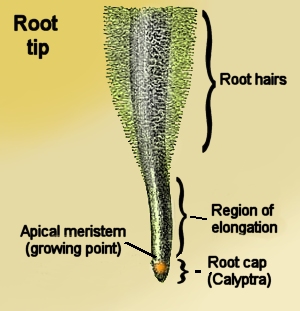 The elongation of the parenchyma
cells pushes the root tip into the
soil, the calyptra covers and protects
the delicate apical meristem
from abrasion as it grows through
the soil.
The root cap is formed by several layers of
cells that envelop the root tip
externally. This covering of cells, of which the outermost ones are
dead, envelops and protects the growing tip very much as a thimble
protects the finger. It extends back over the root for a distance
usually of about a millimetre.
As the root-cap cells mature, they become parenchyma and are constantly
pushed out by the addition of new cells from within. Those on the
outside next to the soil are more or less flattened by pressure from
within and slough off as they rub against soil particles when the root
grows deeper.
The root cap produces a slimy layer of mucilage, known as mucigel
that lubricate the tip. But
throughout the life of the root, even if it penetrates many feet into
the soil, the root cap is so constantly renewed by new cells from within
that the delicate tip is actually pushed through the soil without, as it
were, coming in contact with it. This explains why roots can penetrate
even into stiff clay soils without
buckling. |